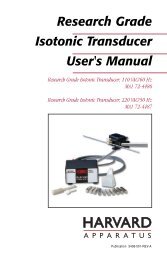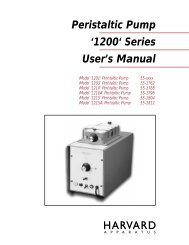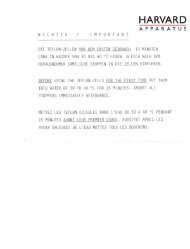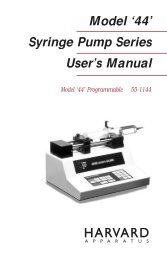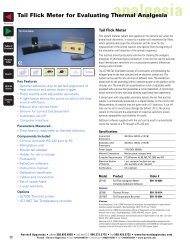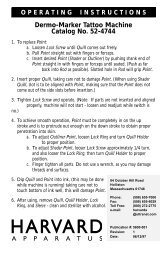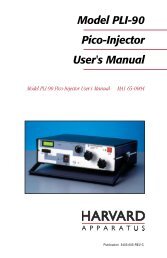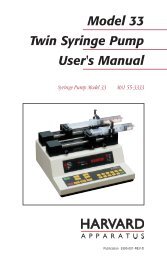manipulators - Harvard Apparatus
manipulators - Harvard Apparatus
manipulators - Harvard Apparatus
Create successful ePaper yourself
Turn your PDF publications into a flip-book with our unique Google optimized e-Paper software.
Dovetail Slide Micro<strong>manipulators</strong>,<br />
see page 3<br />
<strong>manipulators</strong><br />
Products<br />
Page No.<br />
EC1 60-0577 Push Button<br />
Control Units, see page 5<br />
Micro<strong>manipulators</strong><br />
Standard Manual Control Micro<strong>manipulators</strong> 2<br />
Dovetail Slide Micro<strong>manipulators</strong> 3<br />
Standard Motorized Control Micro<strong>manipulators</strong> 4<br />
Control Units for Motorized Manipulators 5<br />
Joystick 6<br />
Ultraprecise Micro<strong>manipulators</strong> 7<br />
HSE-HA Microdrive Controller 864 8<br />
Microdrive 864/1 and 864/2 9<br />
Magnetic Bases 10<br />
Microgripper Motorized Precision Forceps 11 - 12<br />
Books 13<br />
EC1 60-0594 Ultraprecise Manual Control<br />
Micromanipulator, Micropipette Not Included,<br />
see page 7<br />
EC1 73-0000 HSE-HA<br />
Microdrive Controller 864<br />
MT-LS, see page 8<br />
1
micro<strong>manipulators</strong><br />
Standard Manual Control<br />
Micro<strong>manipulators</strong> are among the last of the classic pieces of<br />
research equipment. How they work is precision engineering. How<br />
they ‘feel’ is art. These Micro<strong>manipulators</strong> have set the standard<br />
worldwide for decades. They are the most popular and widely used.<br />
Selecting the correct Micromanipulator for the application is<br />
important. If you are buying one instrument for general laboratory use,<br />
then select the Ultraprecise Micromanipulator, see page 7.<br />
Its rigidity and scope make it ideal for any application. For repetitive<br />
work, where a number of stations may be required, the Standard<br />
Manual Control Micromanipulator with its numerous options generally<br />
meets any requirement. To hold freely mobile cells or manipulate<br />
larger cells, the Micromanipulator with Mechanical Joystick, see page<br />
6, is flexible yet stable.<br />
EC1 60-0570 Left-Handed<br />
Standard Manual Control<br />
Micromanipulator<br />
with 1 Tool/Electrode<br />
Holder,<br />
Micropipettes<br />
not included<br />
Standard Manual Control<br />
Micromanipulator<br />
with 2 Tool/Electrode<br />
Holders,<br />
Micropipette<br />
not included<br />
• 20 mm of travel in lateral (Y-axis) and vertical<br />
(Z-axis) graduated in 0.1 mm increments<br />
• 37 mm of travel in probe direction (X-axis)<br />
graduated in 0.1 mm increments plus 10 mm of<br />
travel with fine positioning in 0.01 mm<br />
increments<br />
• All three control knobs located in a single plane<br />
for one-handed operation and close positioning<br />
of several instruments side-by-side<br />
• For use with microscope magnifications up to<br />
250x<br />
These Micro<strong>manipulators</strong> have three stacked, stainless steel roller bearing<br />
raceways providing movement in the X, Y and Z axes. Rack and pinion<br />
drives minimize backlash and provide fast positioning and long life. The<br />
lateral (Y-axis) and vertical (Z-axis) planes each have 20 mm of travel<br />
graduated in 0.1 mm increments. The probe direction (X-axis) has 37 mm<br />
of travel. Two adjustments are provided. The coarse adjustment is<br />
graduated in 0.1 mm increments while the fine adjustment provides 10<br />
mm of travel with precision positioning graduated in 0.01 mm increments.<br />
A unique and valuable feature of these standard manual control<br />
micro<strong>manipulators</strong> is that the three control knobs are located in a single<br />
plane. This positioning permits one-handed control of a single instrument,<br />
without taking the operator’s eyes from the microscope. It also allows several<br />
Micro<strong>manipulators</strong> to be closely positioned side-by-side with all control knobs<br />
easily accessible. They are available for both right- and left-handed use.<br />
Tool/Electrode Holder<br />
Each Micromanipulator is supplied complete with one or two tool/<br />
electrode holders. The second holder has two fine controls that allow<br />
movement of 8 mm in both the lateral (Y) and probe (X) direction<br />
independent of the Micromanipulator. Two additional fine controls allow<br />
this second tool/electrode holder to be tilted and swiveled.<br />
Tilt Base or Clamp Mounting<br />
Each Micromanipulator is offered with a choice of either a tilt base or a clamp<br />
to mount the Micromanipulator on a 13 mm ( 1 ⁄2 in) OD vertical rod. Other<br />
clamps are available as accessories. For a selection of proper stands with 13<br />
mm ( 1 ⁄2 in) OD rods, see the Stronghold Clamps, Stands and Lattices on the<br />
<strong>Harvard</strong> <strong>Apparatus</strong> website: www.harvardapparatus.com. The tilt base<br />
permits the Micromanipulator to be tilted 80° from the vertical. The<br />
<strong>manipulators</strong> with clamp mount are supplied with a 1 ⁄2 in. to 10 mm bushing<br />
which permits mounting on a magnetic base, see page 10.<br />
Standard Manual Control Micromanipulator<br />
One Holder Price $ Two Holders Price $<br />
Right-Handed<br />
Clamp EC1 64-0056 765.00 EC1 60-0569 1,638.00<br />
Tilt Base EC1 64-0058 988.00 –<br />
Left-Handed<br />
Clamp EC1 64-0055 765.00 EC1 60-0570 1,347.00<br />
Tilt Base EC1 64-0057 988.00 –<br />
Order # Product Price $<br />
EC1 69-1066 10 mm Rod Clamp, for use with Magnetic Bases 44.00<br />
EC1 69-1067 12 mm Rod Clamp, for use with Magnetic Bases 44.00<br />
EC1 60-0604 Tool Holder, pkg. of 3 140.00<br />
EC1 64-1652 1<br />
⁄2 in Rod Clamp xxx.00<br />
EC1 64-1652WB 1 ⁄2 in Rod Clamp with 1 ⁄2" to 10 mm blushing xxx.00<br />
<strong>Harvard</strong> <strong>Apparatus</strong> • phone 508.893.8999 • toll free U.S. 800.272.2775 • fax 508.429.5732 • www.harvardapparatus.com<br />
2
micro<strong>manipulators</strong><br />
Dovetail Slide Micro<strong>manipulators</strong><br />
Electrode Holder not included.<br />
Retangular base (72-6034) and 10c<br />
mounting ring bracket (72-6051)<br />
need to purchase separately<br />
• Brass dovetail slide construction – strong and<br />
durable<br />
• Available with fixed or tiltable X-axis arm<br />
• Stable probe clamp allows for firm hold of 1⁄4 to<br />
1⁄2 inch probe, rod or electrode<br />
• Available for right- or left-handed use<br />
Manufactured from brass, these Dovetail Slide Micro<strong>manipulators</strong> are<br />
significantly more durable, and hold greater weight without slippage or<br />
drift, than any ball bearing slide micromanipulator available.<br />
Micro<strong>manipulators</strong> are available with a fixed or a tiltable X axis arm. The<br />
fixed arm version has the X axis locked at precisely 90°. The tilt arm<br />
version can be rotated to any desired angle and securely locked.<br />
The dovetail slides are driven by rack and pinion mechanisms for rapid<br />
positioning to a resolution of 0.1 mm on the coarse vertical (Z) and lateral<br />
(Y) drives. The probe direction (X) drive is also graduated in 0.1 mm<br />
increments, and has an anti-backlash worm drive for more precise control<br />
of movement.<br />
The fine drive, graduated in 0.01 mm increments, is located on the base<br />
of the Z axis. This is especially useful where the specimen is in a Petri<br />
dish or microtiter tray. The probe holder allows mounting of any rod or<br />
pipette, even up to 1 ⁄2 inch diameter. These micro<strong>manipulators</strong> can be<br />
mounted directly on several bases via the most secure dovetail slide<br />
mount. Alternatively, a mounting ring bracket is available, which allows<br />
mounting onto any 1 ⁄2 inch rod.<br />
The adjustable probe clamp allows firm hold of the widest range of probe<br />
and electrode diameters, providing absolutely steadfast grip of any probe,<br />
rod or electrode holder from 1 ⁄4 to 1 ⁄2 inches.<br />
Rectangular base and mounting ring bracket must be purchased<br />
separately.<br />
Specifications<br />
Axis Range Resolution<br />
X 65 mm 0.1 mm<br />
Y 29 mm 0.1 mm<br />
Z 65 mm 0.1 mm<br />
Z fine 2.2 mm 0.01 mm<br />
Weight (without base) 1.25 kg<br />
Order # Product Price $<br />
EC1 72-6030 Right-Handed Fixed Axis 1,400.00<br />
EC1 72-6031 Right-Handed Tilt Arm 1,500.00<br />
EC1 72-6032 Left-Handed Fixed Axis 1,400.00<br />
EC1 72-6033 Left-Handed Tilt Arm 1,500.00<br />
EC1 72-6034 Rectangular Base 250.00<br />
EC1 72-6051 Mounting Bracket* 66.00<br />
*Rectangular base not included<br />
<strong>Harvard</strong> <strong>Apparatus</strong> • phone 508.893.8999 • toll free U.S. 800.272.2775 • fax 508.429.5732 • www.harvardapparatus.com<br />
3
micro<strong>manipulators</strong><br />
Standard Motorized Control Micro<strong>manipulators</strong><br />
EC1 60-0571 Standard Motorized<br />
Control Micromanipulator<br />
with EC1 60-0577 Push Button<br />
Control Unit and EC1 60-0604<br />
Tool Holder,<br />
purchased separately,<br />
micropipette not included<br />
Detail of Fine<br />
Adjustment Control<br />
• Requires one of four control units offered on the<br />
following page.<br />
• Available with choice of:<br />
– 1- or 2-tool/electrode holders<br />
– Tilt base or clamp mounting<br />
– Right- or left-handed use<br />
• 20 mm of travel in lateral (Y-axis) and vertical<br />
(Z-axis) graduated in 0.1 mm increments<br />
• 37 mm of travel in probe direction (x-axis)<br />
graduated in 0.1 mm increments<br />
• All three control knobs located in single plane for<br />
ease of operation and close positioning of several<br />
instruments side-by-side<br />
• For use with microscope magnifications up to<br />
250x<br />
• Positioning in sub-micron range is possible<br />
• Smallest step size is 0.5 µm<br />
• Micromanipulator does not have to be touched<br />
for fine adjustment<br />
• Flexible motor coupling ensures zero vibration of<br />
probe during movement<br />
• Marzhauser’s DC31C<br />
This Standard Motorized Micromanipulatori has the same manual coarse<br />
adjustment for each of the three axes graduated in 0.1 mm increments:<br />
X-axis 37 mm of travel; Y- and Z-axes 20 mm of travel each. On each of the<br />
three axes there is installed an additional fine adjustment slide with builtin<br />
miniature DC-motors rotating micrometer spindles. This motorized fine<br />
adjustment has 10 mm (2-1/2 in) of travel on each axis and the scales read<br />
to 0.01 mm. (Note: For operation, these Motorized Micro<strong>manipulators</strong><br />
require one of the control units listed on the following page.)<br />
These Micro<strong>manipulators</strong> provide ‘hands off’ control for fine adjustments.<br />
Each axis has a controller motor with a flexible coupling to the micrometer<br />
spindle which ensures that the probe can be moved with zero vibration.<br />
They are available with one or two tool/electrode holders. The<br />
micromanipulator with two tool/electrode holders has a swing-in/swingout<br />
platform. This feature permits the entire x-axis platform with tool<br />
holder to be swung out to the side for rapid and easy exchange and<br />
cleaning of tools, capillaries, electrodes, etc. After exchange/cleaning of<br />
tools, the platform swings back to the prior working position without<br />
losing time for readjustment. The micro<strong>manipulators</strong> with this X-axis tilt<br />
should always be mounted in the vertical position to make best use of the<br />
tilting fine control.<br />
Standard Motorized Control Micromanipulator<br />
Two<br />
One<br />
with X-Axis<br />
Electrode<br />
Platform<br />
Holder Price $ Swing-Out Price $<br />
Right-Handed<br />
Clamp Base EC1 60-0571 2,675.00 EC1 60-0600 2,728.00<br />
Left-Handed<br />
Clamp Base EC1 60-0572 2,550.00 EC1 60-0601 2,439.00<br />
(20 x 12 x 11 cm)<br />
Tilt Base EC1 60-0574 2,387.00 –<br />
Note: These Standard Motorized Control Micro<strong>manipulators</strong> require one of the control<br />
units described on the following page.<br />
<strong>Harvard</strong> <strong>Apparatus</strong> • phone 508.893.8999 • toll free U.S. 800.272.2775 • fax 508.429.5732 • www.harvardapparatus.com<br />
4
micro<strong>manipulators</strong><br />
Control Units for Motorized Manipulators<br />
Choice of two control units with<br />
increasing complexity<br />
• Push button control unit<br />
• 3-direction joystick control unit<br />
EC1 60-0577 Push Button<br />
Control Unit<br />
• Provides simultaneous movement in three axes<br />
• Permits easy placement of probe within accuracy<br />
of 2 or 3 µm<br />
• For either ‘step’ or continuous motion<br />
• Simple push button control<br />
Push Button Control Unit<br />
Movement, forward or back, in each of three axes is controlled by six push<br />
buttons. The amount of time the button is depressed determines the type<br />
of movement that occurs. By pressing a button for less than 1 second, a<br />
‘step’ movement is provided. Pressing the button for more than 1 second<br />
activates continuous movement until the button is released.<br />
This control unit has two control knobs: one for ‘step’ size and one for<br />
continuous motion speed. The ‘Step’ size knob ranges from 0.5 to 10<br />
microns graduated in 0.5 micron increments. The continuous motion knob<br />
provides speeds up to 0.2 mm/sec. The ‘step’ size and speed are equal for<br />
all three axes. Backlash on reversing directions has been essentially<br />
eliminated with this control unit. At each reversal an additional current<br />
pulse compensates almost completely for gear/spindle slack. This is<br />
particularly important in the step mode as it eliminates ‘dead steps’ when<br />
the motor turns but the micromanipulator does not move. For use on either<br />
115/230 VAC, 50/60 Hz.<br />
3-Direction Joystick Control Unit<br />
This control unit permits control of movement in three directions<br />
simultaneously. The speed and direction of forward or backward<br />
movement is regulated by the degree of displacement of the joystick from<br />
the central null position. The third axis of simultaneous movement is<br />
obtained by rotating the joystick handle. For use on either 115/230 VAC,<br />
50/60 Hz. Supplied with a screened cable.<br />
Order # Product Price $<br />
EC1 60-0581 3-Direction Joystick Control Unit 983.00<br />
EC1 60-0580 Replacement Screened Cable 122.00<br />
EC1 60-0604 Tool Holder, pkg. of 3 140.00<br />
EC1 69-1066 10 mm Rod Clamp, for use with Magnetic Bases 44.00<br />
EC1 69-1067 12 mm Rod Clamp, for use with Magnetic Bases 44.00<br />
Order # Product Price $<br />
EC1 60-0577 Push Button Control Unit 1,115.00<br />
<strong>Harvard</strong> <strong>Apparatus</strong> • phone 508.893.8999 • toll free U.S. 800.272.2775 • fax 508.429.5732 • www.harvardapparatus.com<br />
5
micro<strong>manipulators</strong><br />
Joystick<br />
Micromanipulator Joystick<br />
• Joystick reduction gear ratio from 1:15 to 1:150<br />
• Fine positioning on Z-axis (vertical) gives 3 mm<br />
(0.12 in) of movement per revolution<br />
• Lever tips the tool quickly for such actions as<br />
hanging a petri dish and the preset stop returns<br />
tool tip to focus plane<br />
• Stop screw prevents damaging probe tip<br />
• Probe holder tilts to 90°<br />
• Available for right- or left-handed use<br />
With this very sensitive mechanical joystick micromanipulator, motion,<br />
even in the micron range, is possible. This micromanipulator is so stable<br />
and strong that it can accommodate even piezo-steppers. Joystick<br />
micro<strong>manipulators</strong> provide movement of probes that are direct reductions<br />
of the speed and direction of the hand movement. Under the microscope,<br />
the probe appears to move directly with the hand.<br />
Typical applications for the Joystick micromanipulator are positioning of<br />
holding pipettes, to grab and hold freely mobile cells, or the manipulation<br />
of larger cells. The joystick drives the probe in the X (probe) and Y<br />
(horizontal) directions. The reduction of the joystick travel relative to the<br />
hand may be adjusted from 1:15 to 1:150. The travel of the joystick ranges<br />
from 0.35 to 4 mm (0.014 to 0.16 in) depending on the reduction gear ratio<br />
being employed.<br />
The Z-axis also has a fine movement with a reduction gear ratio of 1:10<br />
relative to the coarse movement. This fine movement is operated by a<br />
further knob on the Z-axis providing 3 mm (0.12 in) of movement per<br />
revolution. The Z-axis has a lever on the coarse adjust which enables the<br />
operator to lift the tool tip quickly for such operations as changing a petri<br />
dish. A preset stop ensures that the tool tip will return to the previous<br />
focusing plane when again lowered. The stop screw prevents the probe<br />
from being inadvertently broken by being driven into the slide or dish. The<br />
stop screw also prevents downward drift of the micromanipulator so that<br />
the pipette or electrode may be left in a stable position over a long period<br />
of time. The probe holder may be tilted up to 90°.<br />
This joystick micromanipulator is offered in right- or left-handed versions.<br />
It is also offered with a mounting clamp for a 13 mm ( 1 ⁄2 in) OD vertical rod<br />
or with a wide table clamp, when particularly stable mounting is required.<br />
Joystick Micromanipulator Coarse Positioning<br />
Axis<br />
Travel<br />
X (probe)<br />
Y (horizontal)<br />
Z (vertical)<br />
37 mm (1.45 in)<br />
20 mm (0.79 in)<br />
25 mm (1 in)<br />
Order # Product Price $<br />
EC1 60-0582 Right-Handed Joystick Micromanipulator with 1,659.00<br />
Mounting Clamp for 13 mm (0.5 in) Rod<br />
EC1 60-0583 Left-Handed Joystick Micromanipulator with 1,659.00<br />
Mounting Clamp for 13 mm (0.5 in) Rod<br />
EC1 60-0604 Tool Holder, pkg. of 3 140.00<br />
EC1 69-1066 10 mm Rod Clamp, for use with Magnetic Bases 44.00<br />
EC1 69-1067 12 mm Rod Clamp, for use with Magnetic Bases 44.00<br />
<strong>Harvard</strong> <strong>Apparatus</strong> • phone 508.893.8999 • toll free U.S. 800.272.2775 • fax 508.429.5732 • www.harvardapparatus.com<br />
6
micro<strong>manipulators</strong><br />
Ultraprecise Micro<strong>manipulators</strong><br />
These ultraprecise micro<strong>manipulators</strong> have the mass, 6 kg (13.2 lb),<br />
and solid workmanship to support the most precise movement with a<br />
minimum of hand-transmitted vibration, backlash or drift.<br />
The instrument can be used alone or can serve as an ideal mount<br />
for even more precise microdrives. For ultimate precision the<br />
ultraprecise micromanipulator is available with motorized control on<br />
either two or three axes for essentially vibration-free steps as small<br />
as 0.01 mm.<br />
• Available with manual control or<br />
motorized control<br />
Ultraprecise Motorized Control<br />
Micromanipulator<br />
This ultraprecise motorized control micromanipulator is offered either with<br />
stepper motors on two axes or on all three axes. These motors are controlled<br />
by a precision controller that is supplied with the instrument. The same<br />
micrometers are used, as with the manual version, with a travel of 25 mm (1<br />
in). The controller provides fast motor speed of 9 revolutions/sec which<br />
allows a maximum velocity of 36 mm/sec. Speed is infinitely variable to a<br />
slowest speed of 40,000 steps per revolution which corresponds to 0.01 µm<br />
per step. Only by these extremely small single steps can an operator be<br />
assured of essentially vibration-free movement. The controller works in a<br />
vector mode, that is, the target coordinates are approached directly in a<br />
straight line from the starting point. In all modes there are end stop switches.<br />
The movement can be programmed on a thumb wheel switch and is started<br />
by a press button. Alternatively, advance and retraction may be controlled<br />
by manual operation of buttons. A return button causes the probe to be<br />
retracted to the zero position. The Motorized Controller is available with or<br />
without a display. The Controller with Display monitors the location of the<br />
probe on a six digit LED counter. A clear button resets the position to zero.<br />
Movement may also be made by joystick. These joystick movements are<br />
also monitored and may be both displayed on the controller and read via<br />
the RS-232 interface. The Controller may be used either alone or computer<br />
driven via the RS-232 interface. Power 115/230 VAC, 50/60 Hz.<br />
Ultraprecise Motorized Control Micromanipulator<br />
With Stepper Motors<br />
Controller On 2 Axes Price $ On 3 Axes Price $<br />
With Display EC1 60-0586 9,542.00 EC1 60-0590 11,643.00<br />
Without Display EC1 60-0588 9,355.00 EC1 60-0592 11,414.00<br />
EC1 60-0594 Ultraprecise Manual Control<br />
Micromanipulator, Micropipette Not Included<br />
Marzhuser’s HS6 inconjunction with the MCL<br />
Controller - steps as small as 0.01 mm are achieved<br />
comes with push buttom - joystick not included<br />
Ultraprecise Manual Control<br />
Micromanipulator<br />
The base of the manual micromanipulator is in keeping with the mass and<br />
stability of the entire instrument. It is 14 x 14 cm (5-1/2 x 5-1/2 in), has a three<br />
point rest and is bored for four M6 bolts. The large diameter micrometer<br />
spindles on each axis have fine adjustment only with 25 mm (1 in) of travel that<br />
can be read direct to 5 µm and interpolated to a 1 µm positioning resolution.<br />
The entire micromanipulator can be tilted forward up to 25° so that cells<br />
can be penetrated along the axis of one of the drives. The same locking<br />
screw that controls the tilt also provides coarse height adjustment. The<br />
probe holder has multiple locking swivels allowing it to be positioned at<br />
any angle relative to the X, Y or Z axes.<br />
Order # Product Price $<br />
EC1 60-0594 Ultraprecise Manual Control Micromanipulator 3,000.00<br />
EC1 60-0604 Tool Holder, pkg. of 3 140.00<br />
EC1 69-1066 10 mm Rod Clamp, for use with Magnetic Bases 44.00<br />
EC1 69-1067 12 mm Rod Clamp, for use with Magnetic Bases 44.00<br />
<strong>Harvard</strong> <strong>Apparatus</strong> • phone 508.893.8999 • toll free U.S. 800.272.2775 • fax 508.429.5732 • www.harvardapparatus.com<br />
7
micro<strong>manipulators</strong><br />
HSE-HA Microdrive Controller 864<br />
• Single-axis motorized micrometer drive controller<br />
• Alternative to hydraulically-operated micro drive<br />
The HSE-HA Microdrive Controller Type 864 is a single-axis control unit<br />
with microprocessor control for operating motorized micrometer drives<br />
(vernier controls) with DC motor. It has been specially developed to meet<br />
the requirements in physiological and pharmacological research. It is<br />
ideally suitable as control unit for the remote operation and vibration-free<br />
movement of microelectrodes or capillaries, e.g. in intracellular potential<br />
recording, patch clamp experiments or stereotaxic investigations in the<br />
brain. When used with either the micrometer drive HSE-HA 864/1 or<br />
864/2, see following page, the Microdrive Controller thus represents a<br />
complete alternative to hydraulic micro drives which have now become<br />
very expensive. Apart from its compact size, similar to a remote control<br />
for a TV set, a special feature is the combination of continuous and<br />
stepping linear operation. In the continuous mode the micrometer drive is<br />
operated by the joystick shift in the direction IN or OUT. The drive speed<br />
is proportional to the displacement of the joystick. In the switch mode the<br />
micrometer drive is moved by the joystick either IN or Out by a preset<br />
step. The size of the step can be adjusted continuously with the STEP<br />
BS4DTH potentiometer from ~0.5 µm to approx. 0.1 mm per step. This<br />
operating mode is particularly useful when advancing glass<br />
microelectrodes into the cell membrane for intracellular potential<br />
recording. In order to reduce interference emission to a minimum, e.g. in<br />
the input circuit of a microelectrode amplifier, special attention has been<br />
paid in the design of the instrument to good electrical de-coupling and<br />
screening. The system consists of the Microdrive Controller 864, mains<br />
adapter, ground cable, foil-screened connecting cable for micrometer drive<br />
and operating instructions.<br />
Specifications<br />
Operating Mode<br />
Accuracy<br />
Motor Voltage<br />
Motor Current<br />
Overload Protection<br />
Continuous Operating<br />
Mode<br />
Pulse width modulation under microprocessor control<br />
Real information on resolution obtainable, positioning<br />
accuracy, compensation of play and min/max<br />
displacement speed cannot be provided for controller<br />
alone; these are affected largely by drive mechanics,<br />
loading, sliding and sticking friction in guides,<br />
operating position, and manufacturing tolerances<br />
10 to 15 V DC (depending on mains supply unit used)<br />
Nominally 100 mA<br />
Output current is monitored continuously to protect<br />
drive mechanics and motor; switch-off limit can be<br />
adapted by trimmer potentiometer to suit individual<br />
micrometer drive used<br />
Manual displacement proportional to movement of<br />
joystick in IN or OUT direction<br />
Stepping Operating Mode Step-wise displacement by amount set on STEP<br />
BS4DTH potentiometer<br />
Fast Mode<br />
Changes displacement speed for fast movement of<br />
micrometer drive<br />
Backlash Compensation Backlash in gearing is compensated by means of<br />
additional displacement pulse on change of direction;<br />
pulse length can be adjusted to individual mechanism<br />
Monitor LEDs<br />
Brightness-modulated indicating LED for IN and OUT<br />
directions to indicate control voltage produced<br />
Beep<br />
Short audible signal when triggering pulse in stepping<br />
mode or error message on over-current switch-off<br />
Supply<br />
230 V AC (115 V AC) through external mains adapter to<br />
suit<br />
local supply, or directly by 12-15 V DC or AC, 150 mA<br />
Dimensions, W x H x L 45 x 130 x 70 mm (1.8 x 5.1 x 2.8 in)<br />
Weight<br />
250 g (8.8 oz)<br />
Note: The motorized micrometer drive required for operation is not included with the<br />
controller and has to be ordered additionally, e.g. HSE Type 864/1 or Type 864/2.<br />
Order # Product Price $<br />
EC1 73-0000 Microdrive Controller 864, 115 VAC, 60 Hz 1,427.00<br />
EC1 73-0001 Microdrive Controller 864, 220 VAC, 50 Hz 1,385.00<br />
<strong>Harvard</strong> <strong>Apparatus</strong> • phone 508.893.8999 • toll free U.S. 800.272.2775 • fax 508.429.5732 • www.harvardapparatus.com<br />
8
micro<strong>manipulators</strong><br />
Microdrive 864/1 and 864/2<br />
• Perfect for intracellular recording<br />
• Resolution down to 2 µm<br />
HSE-HA Microdrive 864/1<br />
The motorized micrometer drive Type 864/1 is based on the motor X axis<br />
of the long-established micromanipulator DC-3K. Together with the HSE-<br />
HA Microdrive Controller Type 864 it permits remotely controlled<br />
displacement of microelectrodes or capillaries, e.g. in intracellular<br />
potential recording, patch clamp experiments or stereotaxic investigations<br />
in the brain. It thus represents a complete alternative to hydraulic micro<br />
drives which have now become very expensive. The mechanism is based<br />
on a conventional micrometer screw with a displacement of 10 mm. The<br />
micrometer scale is visible and permits reading to 10 µm. The drive is<br />
powered by a flange-mounted DC motor with gearbox. The micrometer<br />
drive slider moves on a precision crossed-roller guide.<br />
The excellent rolling properties of the guide ensure absence of sticking<br />
and sliding friction, and therefore no stick-slip effect, so that this design is<br />
ideally suitable for precision displacement systems. The micrometer drive<br />
is mounted at its back through a 7 mm dia. mounting bolt parallel to the<br />
working axis. The drive can therefore be mounted e.g. on the non-remotecontrol<br />
micromanipulator MM-3 in place of the microelectrode holder.<br />
Specifications<br />
Spindle<br />
Precision micrometer<br />
Displacement Range 10 mm<br />
Resolution 2 µm<br />
Drive<br />
DC motor (12 V, 100 mA nom. current)<br />
Gearbox<br />
Spur gearing; compensation of gearing backlash is through<br />
backlash correction setting of HSE Microdrive Controller<br />
Type 864<br />
Connection Cable Foil-screened cable with moulded Mini-DIN plug suitable<br />
for HSE Microdrive Controller Type 864 (approx. 1.60 m<br />
long)<br />
Scale According to displacement, 0 to 10 mm, reading accuracy 10<br />
µm<br />
Case<br />
Rigid aluminium, black anodized<br />
Mounting<br />
On back, offset 7 mm clamping bolt parallel to working axis<br />
Dimensions (H x W x D) 112 x 25 x 32 cm (4.4 x 1 x 1.3 in), sizes without fitted<br />
microelectrode holder and mounting bolt<br />
Weight<br />
320 g (11.3 oz)<br />
Order # Product Price $<br />
EC1 73-0003 DC Microdrive Type 864/1 846.00<br />
HSE-HA Microdrive 864/2<br />
The motorized micrometer drive Type 864/2 offers excellent displacement<br />
characteristics, as required e.g. for inserting glass microelectrodes during<br />
intracellular measurement. Together with the control unit (HSE-HA<br />
Microdrive Controller Type 864) the Microdrive Type 864/2 represents a<br />
complete alternative to previous hydraulic micro controls for the remote<br />
operation and vibration-free insertion of the microelectrode into the cell<br />
membrane. In addition to the compact construction, a special feature is<br />
the backlash-free circulating-ball spindle and the limit switch built into the<br />
mechanism. The circulating-ball spindle requires no maintenance and<br />
operates virtually without friction, unlike a micrometer spindle with sliding<br />
bearing. Freedom from backlash is achieved through the use of factoryselected<br />
balls and is maintained through a very long operating life.<br />
Absence of sliding friction inside the circulating-ball spindle ensures<br />
freedom from the so-called stick-slip effect. As a result the mechanism<br />
accurately follows even the slightest displacement settings.<br />
Specifications<br />
Spindle Drive<br />
Hardened and ground circulating-ball spindle,<br />
freedom from axial play through use of selected balls<br />
Resolution ~1 µm<br />
Maximum Loading in both directions 50 N<br />
Displacement Range 25 mm (50 and 75 mm options also available)<br />
Bi-Directional Repeatability ±2 µm<br />
Uni-Directional Repeatability±0.1 µm<br />
Drive<br />
DC motor with flanged gearbox (12 V, 170 mA nom.<br />
current)<br />
Gearbox<br />
76:1, with backlash (optionally without backlash);<br />
backlash compensation normally through backlash<br />
correction adjustment of HSE Microdrive Controller<br />
Type 864<br />
Connection Cable Foil-screened cable with moulded Mini-DIN plug<br />
suitable for HSE Microdrive Controller Type 864<br />
(approx. 1.60 m L)<br />
Limit Switch<br />
To protect drive unit, wired internally, with evaluation<br />
of displacement direction<br />
Scale<br />
To suit displacement, 0 to 25 mm<br />
Case<br />
Rigid aluminium, black anodized<br />
Mounting<br />
Clamping fitting 12 mm D and 10 mm clamping width<br />
Dimensions<br />
Length 196 mm, motor case D. 20 mm<br />
Spindle Connection M6 x 0.5 mm, 6 mm deep<br />
Weight<br />
360 g (12.7 oz)<br />
Order # Product Price $<br />
EC1 73-0011 DC Microdrive Type 864/2 2,680.00<br />
<strong>Harvard</strong> <strong>Apparatus</strong> • phone 508.893.8999 • toll free U.S. 800.272.2775 • fax 508.429.5732 • www.harvardapparatus.com<br />
9
Magnetic Bases<br />
<strong>manipulators</strong><br />
EC1 69-0226<br />
EC1 69-0225<br />
EC1 69-0227<br />
EC1 69-0230<br />
EC1 69-0229<br />
• Holds with powerful magnetic force<br />
• Perfect for use with micro<strong>manipulators</strong><br />
• Easy on-off control lever<br />
EC1 69-0231<br />
EC1 69-0237<br />
EC1 69-0234<br />
Magnetic bases offer a convenient way to mount various tools such as<br />
micro<strong>manipulators</strong> in various positions near to your working site. The easy<br />
to use on-off control lever allows for easy placement of the magnetic base<br />
in the off position. When the control knob is moved to the on position the<br />
magnet is engaged and a powerful magnet field holds the magnetic base<br />
(and tool) securely in place.<br />
A wide variety of models are available with varying rod sizes, mounting<br />
holes and magnetic base mounts to meet every need. When combined<br />
with our line of lightweight breadboards, it provides a configurable<br />
platform for all of your positioning needs. Other configurations of bases<br />
are available, please call our Technical Sales Department for details.<br />
EC1 69-0233<br />
EC1 69-0232<br />
Order # Product Price $<br />
EC1 69-0235 Sub Pole, 10 x 165 mm (D x L) 11.00<br />
EC1 69-0236 Sub Pole, 12 x 165 mm (D x L) 17.00<br />
EC1 69-1066 10 mm Rod Clamp 44.00<br />
EC1 69-1067 12 mm Rod Clamp 44.00<br />
Magnetic Bases<br />
Base Main Pole 1st Sub Pole 2nd Sub Pole<br />
Order # Width Length Height Diameter Length Diameter Length Diameter Length Hold Force Price $<br />
EC1 64-0060 356 mm xx.00<br />
EC1 69-0225 50 mm 58 mm 55 mm 12 mm 176 mm 10 mm 165 mm – – 800 N 53.00<br />
EC1 69-0226 50 mm 58 mm 55 mm 12 mm 194 mm 10 mm 165 mm – – 800 N 94.00<br />
EC1 69-0227 50 mm 58 mm 55 mm 14 mm 178 mm 12 mm 165 mm – – 800 N 85.00<br />
EC1 69-0229 50 mm 73 mm 55 mm 20 mm 178 mm 14 mm 165 mm 12 mm 130 mm 1000 N 174.00<br />
EC1 69-0230 50 mm 58 mm 55 mm 16 mm 315 mm, flex with holder for 8 mm rod 800 N 126.00<br />
Magnetic Holders<br />
Holder Tapped Hole Mounting Screw Holes<br />
Order # Width Length Height Diameter Thread Depth Qty. Diameter Depth Span Hold Force Price $<br />
EC1 69-0231 50 mm 58 mm 55 mm M8 1.25 7 – – – – 800 N 50.00<br />
EC1 69-0232 45 mm 45 mm 20 mm M8 1.25 6 4 M6 6 25 65 N 73.00<br />
EC1 69-0233 65 mm 65 mm 20 mm M8 1.25 6 8 M4 6 25 200 N 108.00<br />
EC1 69-0234 90 mm 90 mm 20 mm M8 1.25 6 8 M4 6 25 250 N 136.00<br />
EC1 69-0237 50 mm 73 mm 55 mm M8 1.25 7 – – – – 1000 N 63.00<br />
<strong>Harvard</strong> <strong>Apparatus</strong> • phone 508.893.8999 • toll free U.S. 800.272.2775 • fax 508.429.5732 • www.harvardapparatus.com<br />
10
micro<strong>manipulators</strong><br />
Microgripper Motorized Precision Forceps<br />
The M-2 incorporates a 7-volt DC motor encoder assembly with variable speed control which precisely open and close attached stainless steel tips<br />
to grip and release specimens. The MG-1000 utilizes a piezoelectric polymer film as the basic component in the gripper assembly for activating the<br />
precise movement of the “tweezer-like” stainless steel tips. Because of its micron-thin thickness and its transducer properties, the film’s response<br />
to electrical inputs is instantaneous and directly proportional to the applied electrical field, thus providing the precise control for<br />
delicate manipulation.<br />
M-2 Microgripper<br />
(micromanipulator<br />
not included)<br />
MG-1000<br />
Microgripper<br />
• Variable and controlled gripping forces to insure<br />
a delicate “touch” when handling sensitive<br />
specimens<br />
• Interchangeable gripper tips for microgripping<br />
applications<br />
• Precise directional control of the Microgripper at<br />
any axis and angle when used in conjunction<br />
with commercially available micro<strong>manipulators</strong><br />
• Manual or computer driven controllers with<br />
resolution up to 1.0 micron for high accuracy use<br />
Microgrippers have substantially reduced the size of objects that can be<br />
precisely manipulated by several orders of magnitude. The M-2 and MG-<br />
1000 Microgrippers are evolutionary products designed to provide high<br />
accuracy manipulation of microscopic specimens with precise and<br />
predictable control of the direction and force applied to any object. This<br />
new level of control allows you to selectively handle even the smallest<br />
samples such as cells, insects, bacteria, fine wire, optical elements, and<br />
electronic microcircuits without causing damage to the object.<br />
The key characteristics of these Microgrippers are:<br />
• Variable and controlled gripping forces to insure a<br />
delicate "touch" when handling sensitive<br />
specimens<br />
• Interchangeable gripper tips for<br />
microgripping applications<br />
• Precise directional control of the Microgripper at<br />
any axis and angle when used in conjunction with<br />
commercially available micro<strong>manipulators</strong><br />
• Manual or computer driven controllers with<br />
resolution up to 1.0 micron for high accuracy use<br />
The Technology<br />
The M-2 incorporates a 7-volt DC motor encoder assembly with variable<br />
speed control which precisely open and close attached stainless steel tips<br />
to grip and release specimens. The MG-1000 utilizes a piezoelectric<br />
polymer film as the basic component in the gripper assembly for<br />
activating the precise movement of the "tweezer-like" stainless steel tips.<br />
Because of its micron-thin thickness and its transducer properties, the<br />
film's response to electrical inputs is instantaneous and directly<br />
proportional to the applied electrical field, thus providing the precise<br />
control for delicate manipulation.<br />
The Microgripper Systems are comprised of the Microgripper assembly<br />
with interchangeable Gripper Tips, and a Controller. The system is fully<br />
compatible with any available micromanipulator.<br />
Microgripper Controllers<br />
The MC was designed for precise position control of the M-2<br />
Microgripper Control Stage. The MC Micro positioning Controller is an<br />
open-loop position controller with an encoder. The term "open-loop"<br />
means that operation is not dependent on positional feedback. The MC<br />
will control any 6 -12 volts, DC brush type motor. A 6-digit LCD display<br />
provides the user with positional information which is relative to the grip<br />
force being applied to the specimen. The C-2 Controller is provided with a<br />
15 volt DC Power Adapter.<br />
The MG-1000 utilizes a Model 750 Controller which provides a linear<br />
grip/release control of the gripper tips of the MG-1000 Microgripper via<br />
manually turning the control knob. One complete turn of the knob provides<br />
200 microns of tip displacement. This high resolution enables the MG-<br />
1000 Microgripper to gently hold even the smallest of microscopic<br />
specimens. The Model 750 Controller allows both manual control of the<br />
MG-1000 Microgripper as well as the ability to utilize a foot actuated<br />
variable speed pedal for truly "hands-off" gripping while viewing the<br />
specimen under a microscope.<br />
Variable Gripper Tips for All Applications<br />
The M-2 and MG-1000 Microgripper systems have a broad array of<br />
stainless steel gripper tip options for the most demanding microgripping<br />
applications. The MG-1000 tips range from a length of either 1 or 2<br />
inches with tip diameters from 5 microns to up to 1900 microns (75 mils).<br />
<strong>Harvard</strong> <strong>Apparatus</strong> • phone 508.893.8999 • toll free U.S. 800.272.2775 • fax 508.429.5732 • www.harvardapparatus.com<br />
11
micro<strong>manipulators</strong><br />
Microgripper Motorized Precision Forceps<br />
(continued)<br />
Applications of the M-2 and MG-1000 Microgripper<br />
The Microgripper has been applied to a broad range of applications<br />
where precise movements and, more importantly, specific force control is<br />
required. These applications span the life science fields, industrial<br />
research and production areas. The life science fields represent an ideal<br />
area for high precision manipulation with an added requirement for very<br />
delicate handling capabilities. Recent developments in physiology,<br />
histology, genetic engineering technology, electron microscopy and a host<br />
of other biological sciences have demanded the superior control<br />
capabilities of the Microgripper. The Microgripper System has been<br />
applied to the following life science applications such as cellular<br />
microbiology, microsurgical dissection, cytology and histological studies,<br />
entomology, botanical, and electron microscope sample preparation.<br />
Getting Started<br />
The Microgripper System consists of the M-2 or MG-1000 Microgripper,<br />
Gripper Tips and Controller. A micromanipulator is required to complete the<br />
system. The Microgrippers are compatible with most commercially<br />
available micro<strong>manipulators</strong>.<br />
Order # Product Price $<br />
EC1 72-4670 M-2 Microgripper Assembly with User's 6,370.00<br />
Manual (M-2 Controller and Gripper Tips must be<br />
purchased separately)<br />
EC1 72-4671 M-2 Controller, Manual with Variable 1,300.00<br />
Speed Control<br />
EC1 60-4614 MG-1000 Microgripper Assembly with User's 1,960.00<br />
Manual (750 Controller and Gripper Tips must be<br />
purchased separately)<br />
EC1 60-4627 Model 750 Local and Remote Controller w/Foot 1,136.00<br />
Pedal, 115 VAC, 60 Hz<br />
Specifications<br />
M-2 Microgripper<br />
Weight<br />
Length<br />
Tip Opening<br />
Grip Force<br />
113.5 g<br />
7.50 in with tips<br />
0 to 0.25 in<br />
M-2 Microgripper Controller<br />
Used With<br />
Power<br />
Display<br />
Grip Force<br />
control<br />
MG-1000 Microgripper<br />
Weight<br />
Size<br />
Power<br />
0 mg to 2 oz<br />
EC1 72-4670 Microgripper<br />
110 VAC, 50/60 Hz<br />
Provides relative value of tip opening<br />
Calibrated from encoder count, variable speed<br />
62.5 g<br />
5.1 x 2.2 x 2.2 cm (2 x 7/8 x 7/8 in)<br />
120 VAC, 50/60 Hz<br />
Model 750 Microgripper Controller<br />
Used With<br />
Power<br />
Grip Force<br />
EC1 60-4614 Microgripper<br />
110 VAC, 50/60 Hz<br />
Manual adjustment via control knob, 1 turn provides<br />
200 µm of tip displacement, includes foot switch for<br />
hands off control<br />
M-2 Microgripper Tips<br />
Order # Tapered Tip Width Length of Grip Surface Cylinder Size Gripped Tip Thickness Price $<br />
EC1 72-4672 2 mils 20 mils Straight Tips 10 mils 133.00<br />
EC1 72-4673 5 mils 17 mils 4 to 7 10 mils 133.00<br />
EC1 72-4674 10 mils 17 mils 4 to 7 10 mils 133.00<br />
EC1 72-4675 10 mils 36 mils 8 to 15 20 mils 133.00<br />
EC1 72-4676 50 mils 36 mils 8 to 15 20 mils 133.00<br />
EC1 72-4677 10 mils 2 mils Offset Tips 10 mils 199.00<br />
EC1 72-4678 25 mils 25 mils Angled Tips 10 mils 199.00<br />
MG-1000 Micro Gripper Tips<br />
Order # Tip Length Tip Thickness Tip Diameter Price $<br />
EC1 60-4620 2.54 cm (1 in) 2.5 mils 1.5 mils 126.00<br />
EC1 60-4621 2.54 cm (1 in) 2.5 mils 3.0 mils 126.00<br />
EC1 60-4622 2.54 cm (1 in) 2.5 mils 10.0 mils 126.00<br />
EC1 60-4623 2.54 cm (1 in) 2.5 mils 30.0 mils 126.00<br />
EC1 60-4624 2.54 cm (1 in) 2.5 mils 75.0 mils 126.00<br />
EC1 72-4679 2.54 cm (1 in) 5.0 mils 75.0 mils 126.00<br />
EC1 60-4625 5.1 cm (2 in) 2.5 mils 2.0 mils 126.00<br />
EC1 60-4626 5.1 cm (2 in) 2.5 mils 5.0 mils 126.00<br />
<strong>Harvard</strong> <strong>Apparatus</strong> • phone 508.893.8999 • toll free U.S. 800.272.2775 • fax 508.429.5732 • www.harvardapparatus.com<br />
12
Books<br />
books<br />
Cell Biology: A Laboratory Handbook (Cell Biology Series,<br />
Second Edition)<br />
Julio E. Celis. This comprehensive handbook is likely to become the standard laboratory manual in cell biology.<br />
The second addition contains four volumes in a plastic-comb bound to lie flat. The first volume deals with tissue<br />
culture and associated techniques and discusses viruses. The second volume is dedicated to organelles and<br />
cellular structures, assays, antibodies, immunocytochemistry, cell staining, and internet resources. Volume three<br />
describes light microscopy and contrast generation, electron microscopy, intracellular measurements, cytogenetics<br />
and hybridization, transgenics and gene knockouts. The last volume completes the set by describing topics such<br />
as transfer of macromolecules and small molecules, expression systems, differential gene expression, and<br />
proteins. (2400 pp; 1997)<br />
Order # Product Price $<br />
EC1 69-1060 Cell Biology: A Laboratory Handbook (Cell Biology Series, Second Edition) 302.00<br />
Cellular and Molecular Biology of Nitric Oxide<br />
Jeffrey D. Laskin and Debra L. Laskin. This book is a must for biologists, biochemists, toxicologists, and<br />
pharmacologists interested in the latest advances in nitric oxide biology, biochemistry, and toxicology. The<br />
behavior of this molecule is covered in a wide range of physiologic processes, including respiration, blood<br />
pressure, neurotransmission, host defense, and wound healing. (400 pp; 1999)<br />
Order # Product Price $<br />
EC1 69-1061 Cellular and Molecular Biology of Nitric Oxide 213.00<br />
Microinjection<br />
(Methods & Tools<br />
in Biosciences<br />
and Medicine)<br />
BY JUAN C. LACAL<br />
Microinjection (Methods and Tools in Biosciences and Medicine)<br />
Juan C. Lacal. This detailed book presents information on the principles of microinjection. It also covers the<br />
required equipment, preparation of receiving cells and injected material, and data analysis. Detailed protocols are<br />
provided for several applications in different cell systems and including cell cycle regulation, signal transduction,<br />
transcriptional regulation, cytoskeletal functions, and cell secretion and intracellular transport. A large portion of<br />
the book is also dedicated to the very relevant area of the Xenopus laevis oocyte system. (approx. 350 pp; 1999)<br />
Order # Product Price $<br />
EC1 69-1062 Microinjection (Methods and Tools in Biosciences and Medicine) 208.00<br />
Epithelial<br />
Transport:<br />
A Guide to Methods<br />
and Experimental<br />
Analysis<br />
by<br />
Nancy K. Wills<br />
Epithelial Transport: A Guide to Methods and<br />
Experimental Analysis<br />
Nancy K. Wills et al. This book is designed for all levels ranging from graduate students to established investigators<br />
and clinicians. The fundamental role of the epithelium in water and plasma electrolyte balance is explained in a<br />
fashion that builds from general principles. There is an emphasis placed on methodology and experimental<br />
approaches. The book also contains a highly comprehensive glossary of terms for the reader’s use. (368 pp; 1996)<br />
Order # Product Price $<br />
EC1 69-1064 Epithelial Transport: A Guide to Methods and Experimental Analysis 279.00<br />
Models for<br />
Assessing Drug<br />
Absorption and<br />
Metabolism<br />
(Pharmaceutical<br />
Biotechnology, v. 8)<br />
by Ronald T. Brochardt<br />
Models for Assessing Drug Absorption and Metabolism<br />
(Pharmaceutical Biotechnology, v. 8)<br />
Ronald T. Borchardt et al. Useful for both academic and industrial scientists interested in the field of biopharmaceutical<br />
research. Chapters provide methodologies for the study of several tissues including intestine, respiratory and nasal,<br />
ocular, vaginal, and buccal. The dermal epithelium, endothelial and elimination barriers are also covered. (436 pp; 1996)<br />
Order # Product Price $<br />
EC1 69-1065 Models for Assessing Drug Absorption and Metabolism (Pharmaceutical Biotechnology, v. 8)<br />
<strong>Harvard</strong> <strong>Apparatus</strong> • phone 508.893.8999 • toll free U.S. 800.272.2775 • fax 508.429.5732 • www.harvardapparatus.com<br />
13





